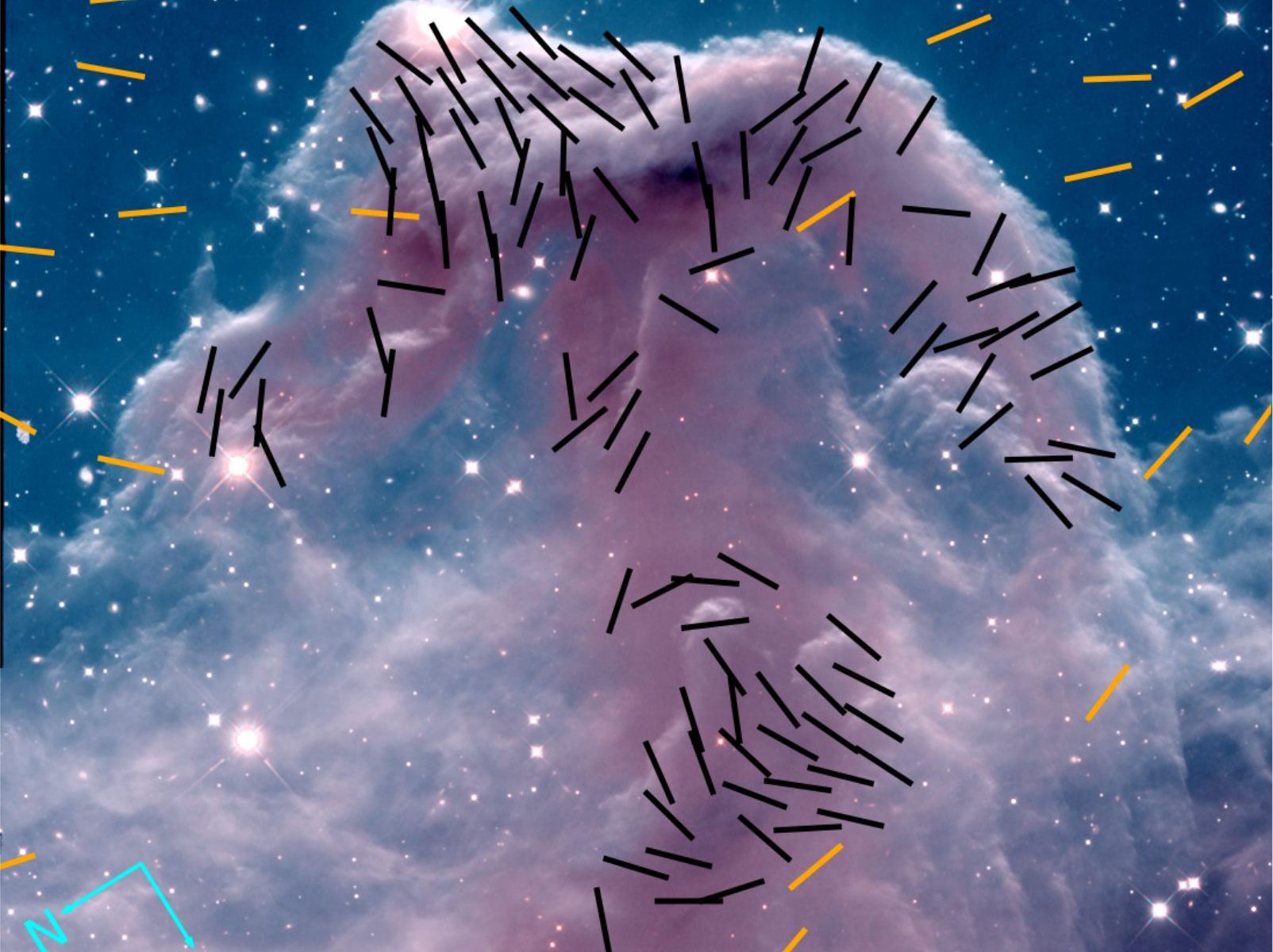Located near the summit of Maunakea, Hawaii, the 15-meter (~49 ft) James Clerk Maxwell Telescope (JCMT) at the East Asia Observatory (EAO) is the largest telescope in the world designed to operate exclusively in the submillimetre-wavelength. In 2018, Molokai’i High School alumna Mallory Go was awarded time with the JCMT under the Maunakea Scholars program. With the assistance of EAO astronomer Dr. Harriet Parsons, Go obtained unique images of the Horsehead Nebula in polarized light, which revealed the nebula’s magnetic fields.
Go (now a graduate student at Brown University) presented the images as part of a Science Fair representing Molokai`i High School. A year later, these observations were used by a team of astronomers from the Korea Astronomy and Space Science Institute (KASI), the University of Science and Technology (UST), and University College London (UCL) to perform a quantitative analysis of the strength and role of magnetic fields in the region. The paper that describes the observations and analysis, “Magnetic Fields in the Horsehead Nebula,” recently appeared in The Astronomical Journal.

The observations taken in 2018 were taken using the JCMT’s POL-2 instrument, a linear polarimeter that obtains polarization data with the help of the Submillimetre Common-User Bolometer Array 2 (SCUBA-2) instrument. Together, these instruments measure how magnetic fields in space influence the alignment of interstellar dust. As Dr. Parsons explained in an EAO press release:
“You can think of POL-2 as a pair of polarized sunglasses sitting in front of the telescope. In Hawaii, many of us are used to wearing polarized sunglasses – they help us to see better by cutting down glare – but at the telescope, by rotating the polarized lenses, we analyze the brightness of the light being observed and deduce if it is under the effect of magnetic fields. Astronomers can look at clouds of gas and dust using such instruments – regions both within our own galaxy or beyond – and expand their understanding of what shapes them.”
The astronomers from KASI, UST, and UCL obtained additional data using the JCMT’s other operational instruments – the Heterodyne Array Receiver Program (HARP) and Auto Correlation Spectral Imaging System (ACSIS) – to measure showed how bright and dense the region. The HARP instrument revealed additional spectral line data that showed the presence of a type of carbon monoxide containing oxygen-18 (C18O), a stable isotope of oxygen thought to originate in molecular clouds. Said UCL astronomer Dr. Kate Pattle, one of the study’s co-authors:
“The data are impressive and what they tell us is even more impressive. I am delighted that Mallory has given us the chance to work on such a beautiful and iconic region of the sky – and what we’ve found helps us to understand why the Horsehead Nebula has the shape that it does. These observations tell us a story of two dense regions hidden in the Horsehead. We see a ridge of warm gas and dust – the head and mane of the horse – that is interacting with the ultraviolet photons from nearby bright young stars.”

The JCMT’s instruments allowed the team to observe the interaction between the nebula’s “head” and “mane” and nearby young stars – which appears to have had a noticeable effect on the nebula’s magnetic field. The team theorized that it folded back on itself along the observatory’s line of sight as the Horsehead Nebula formed. Behind this ridge, they observed a cold clump of dense material that appeared to have been sheltered from these interactions – which they suspect will go on to form a new star system.
This made the observations especially exciting, as they have allowed astronomers to see what magnetic field lines in regions like the Horsehead Nebula are doing for the first time. As Pattle added:
“This gives us important insight into how stars can continue to form even in regions like the Horsehead, where the cold gas that provides the material for new stars is being eroded by photons from nearby young and hot stars. We expect that our own Sun formed as part of a cluster of stars, and so looking at how stars form in the Horsehead Nebula may give us an insight into our own Solar System’s past.”
Though it is an iconic astronomical object, Go’s observations were the first time anyone had attempted to visualize its magnetic field. “When I heard about the Maunakea Scholars program, I was excited,” said Go. “It seemed to me to be such a fantastic opportunity to use the Telescopes on Maunakea. I chose to study the Horsehead Nebula because I thought it was beautiful, and I didn’t find much research on it.”
Further Reading: James Clerk Maxwell Observatory, The Astronomical Journal

